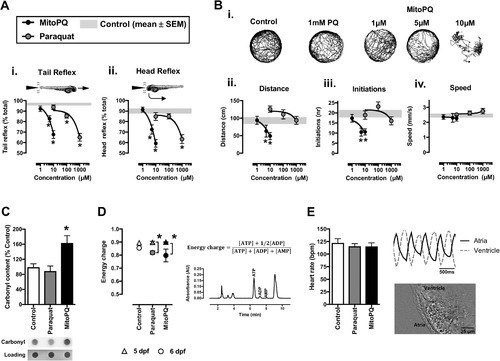Fig. 2
- ID
- ZDB-FIG-190528-2
- Publication
- Pinho et al., 2018 - Mitochondrial superoxide generation induces a parkinsonian phenotype in zebrafish and huntingtin aggregation in human cells
- Other Figures
- All Figure Page
- Back to All Figure Page
|
Behavioral, functional and biochemical parameters in zebrafish treated with MitoPQ vs. Paraquat. Zebrafish were treated with the indicated concentrations of MitoPQ and paraquat, or solvent (control), from 3 dpf until measurements (at 5 or 6 dpf). (A, B) Sensorimotor reflexes and spontaneous movement at 5 dpf: (Ai) tail and (Aii) head reflexes; (Bi) representative trajectories; (Bii) distance; (Biii) initiations, and (Biv) movement speed; n = 27–78 larvae; *P < 0.05 vs. control. (C) Protein carbonyl groups measured by dot-blot at 5 dpf. n = 3 independent experiments, *P < 0.05 vs. control. (D) Left – energy charge values, calculated with the indicated formula, at 5 dpf (triangles) and 6 dpf (circles); Right – representative HPLC chromatogram with adenine nucleotides; n = 3–4 independent experiments. (E) Heart rate and atrioventricular coordination at 6 dpf; n = 16–19 larvae.
|
Reprinted from Free radical biology & medicine, 130, Pinho, B.R., Reis, S.D., Hartley, R.C., Murphy, M.P., Oliveira, J.M.A., Mitochondrial superoxide generation induces a parkinsonian phenotype in zebrafish and huntingtin aggregation in human cells, 318-327, Copyright (2018) with permission from Elsevier. Full text @ Free Radic. Biol. Med.

